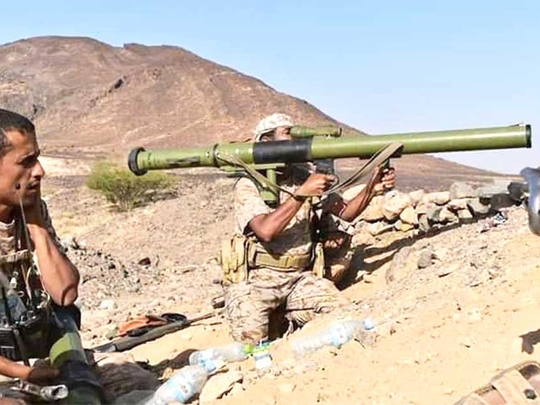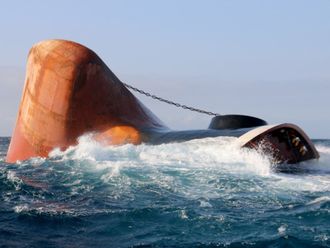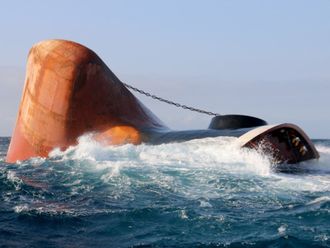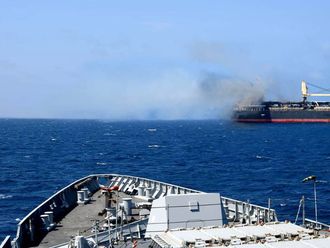
Al Mukalla: Fighting escalated on Wednesday and Thursday outside the Yemeni capital when government forces pressed ahead with an offensive on Al Houthis on Nehim’s rugged mountains in a new bid to break months of military deadlock.
Yemen’s Defence Ministry said that as many as 17 have been killed and dozens injured in the fighting that continued raging for the fifth consecutive day.
Among Al Houthi deaths were three field leaders identified as Ashref Abdu, Abdul Aziz Al Ouqaibi and Ashref Al Shami.
The ministry said in a statement on its official news site, 26sepnews.net that 33 Al Houthi militants, including four military leaders were captured.
The latest escalation of clashes outside Sana’a started several days ago when government forces, backed by massive air support from the Saudi-led coalition, mounted an offensive on a chain of mountains that are still under Al Houthi control in Nehim district, almost 35km from Sana’a.
At least 100 Al Houthi militants and dozens of government troops have been killed since the campaign began.
The Nehim front is the nearest battlefield to Al Houthi-held Sana’a where government forces have struggled to break through Al Houthi defences on a range of strategic mountains that extend to the Sana’a airport.
The ministry said that Saudi-led coalition fighter jets struck Al Houthi gatherings and military vehicles that were heading to the battlefield in Nehim.
Meanwhile in the northern province of Saada, Al Houthi’s heavily fortified bastion, local army commanders said that government forces have intensified attacks against Al Houthi militias in four districts and their defenses have been largely eroded over the last several months.
Brigadier Hussein Hassan, the commander of 6th Border Guards, was quoted by official media as saying that government forces have pushed further into Saada and are now battling Al Houthis in Razah, Ghamar, Baqoum and Ketaf districts for the first time in three years.
The aim of the advancing government forces is Saada city, the capital of Saada province, where the leader of Al Houthi movement is believed to be hiding.
In Marib province, Saudi-led coalition air defence intercepted on a ballistic missile fired by Al Houthis at Marib city, the base of thousands of government and coalition soldiers.
The same air defence systems have destroyed dozens of ballistic missiles aimed at military bases in Marib since the beginning of the Saudi-led coalition military operations in Yemen in 2015.
Heavy fighting was also reported on Thursday in different areas in the northern provinces of Hajja and Jawf.
The Saudi-led Arab coalition entered the Yemeni war in 2015 just months after an Al Houthi coup forced internationally-recognised Yemeni president Abd Rabbo Mansour Hadi out of power.
He later was able to escape house arrest and flee to Aden where he temporarily shifted government headquarters.
Since then, the coalition has gained back 86 per cent of Yemeni territory but major population centres still remain under Al Houthi control.
Saudi Arabia and the US have accused Iran of illegally smuggling weapons into Yemen to sustain Al Houthi war efforts.
One such Iranian-made ballistic missile was fired towards Riyadh last month.
Although it was intercepted, Riyadh called it an ‘act of war’.
The war has cost the lives of thousands of Yemenis and pushed the Arab world’s poorest country to the brink of famine.
The latest government push seeks to take advantage of cracks in the awkward Al Houthi alliance with former Yemeni President Ali Abdullah Saleh’s supporters.
Saleh ruled Yemen for more than three decades until he was forced to resign following an Arab Spring uprising in 2011.
He remained in the country, however, and continued to wield power from behind the scenes.
In 2014, his forces allied with Al Houthi militia, despite the fact that as president he had gone to war with them.
There had been simmering tensions between the two awkward allies in past months that boiled over in December when Saleh suggested he would cooperate with Hadi — he was assassinated shortly after.
Since then senior members of Saleh’s party have either been executed or placed under house arrest by Al Houthis amid a draconion crackdown.
While most analysts say that Saleh’s slaying could give Al Houthis the upper hand in the short term, the broken alliance between Al Houthis and forces loyal to Saleh appears to be permanent, which will help the Yemeni government and its backers in the Saudi-led coalition weaken their grip on the country given the reduction in manpower.












